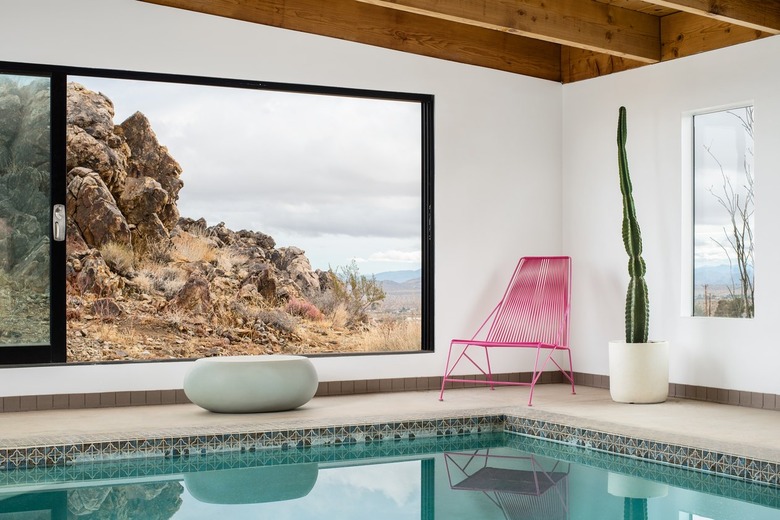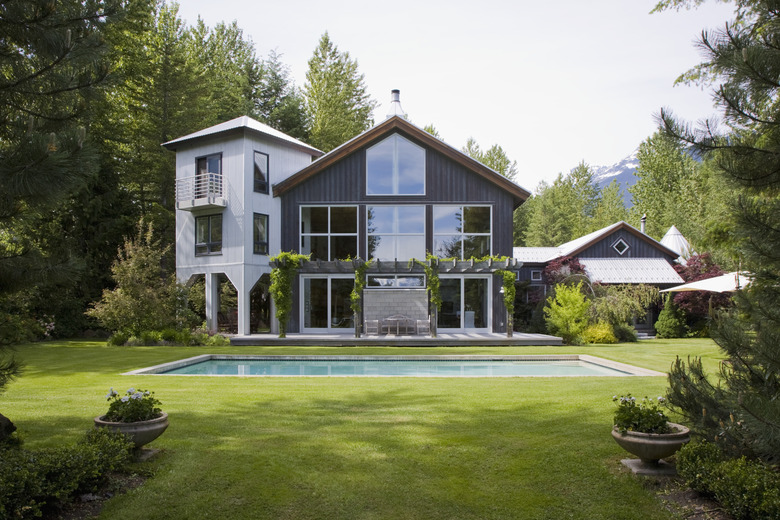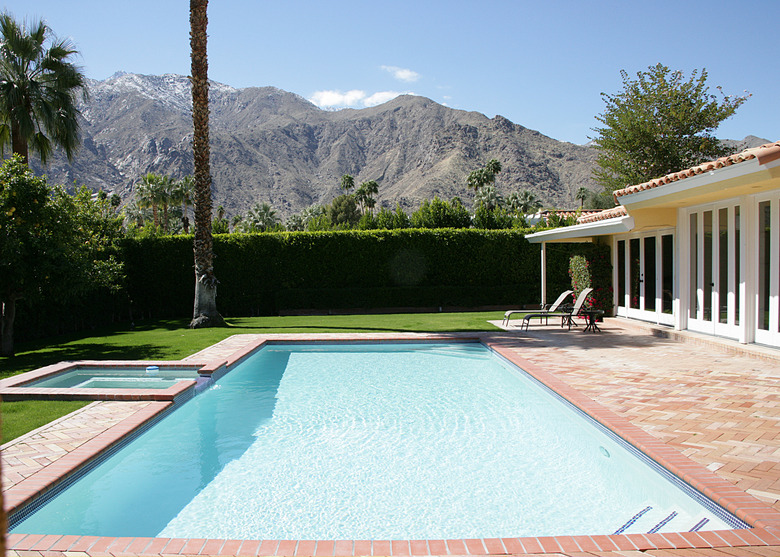8 Tips For Creating An Energy-Efficient Swimming Pool
We may receive a commission on purchases made from links.
Far from being a mere hole in the ground full of water, a swimming pool is an active system that uses electricity — and plenty of it — so if you have one or you're thinking about installing one, it pays to consider the ways you can make an energy-efficient pool. Even though a pool uses chlorine, salt or plants to keep the water hygienic, you have to run a circulation pump to filter out microbes and oxygenate the water, and together with the pool heater, chlorinator and other pool equipment, energy consumption can easily reach 3,000 kilowatt-hours per season or more.
The average electricity cost in the United States is 13 cents per kilowatt-hour, which means that your energy-intensive pool can cost as much as $390 per season to run. If you live in a place like California where power companies charge on a tier system, that much usage can send you to the top tier, where charges are as much as 50 cents per kilowatt-hour, and the pool can cost as much as $1,500 per season. If you use your pool from June to October, that's about $100 per week. Money aside, much of that extra electricity is generated by burning fossil fuels, which just adds more carbon dioxide to the atmosphere and exacerbates the climate crisis.
Taking steps toward an energy-efficient pool is just one way to reduce your energy consumption, and the steps don't have to be huge ones. Simply keeping your pool covered when you aren't using it will help, but if you're willing to retrofit your pool equipment and modify your pool usage, you can go a lot farther on the path to energy efficiency. Consider these eight ways to make an energy-efficient pool.
1. Install a Retractable Solar Pool Cover
1. Install a Retractable Solar Pool Cover
When you keep your pool covered with a solar pool cover, you prevent water evaporation, which the U.S. Department of Energy identifies as the single most important source of overconsumption of energy when it comes to swimming pools. An uncovered pool loses 1 to 1 1/2 inches of water per week, which is equal to about 125 to 150 gallons for a smallish 10 x 20-foot pool. Besides being a waste of a precious resource (water), the heat loss from evaporation makes the pool heater work harder to compensate and maintain a steady temperature.
A solar cover not only keeps water in the pool but it absorbs sunlight and warms the water, giving the pool heater a break. On warm days, you might not need the heater at all; just pull back the cover and jump in. If you install a retractable solar pool cover, it will be that much easier to use, and covering the pool when you're finished swimming will be as easy as closing the door when you leave the house.
2. Provide Shelter for an Energy-Efficient Pool
2. Provide Shelter for an Energy-Efficient Pool
A swimming pool exposed to the elements, especially strong winds, is bound to increase your energy costs. It will lose more water to evaporation and be harder to heat than one that has some shelter. Even a 7-mph wind, which is barely noticeable on a warm day, can increase energy consumption by as much as 300 percent.
You don't have to build a pool house around the pool, although that wouldn't be a bad idea, but you should at least provide a windbreak. It can take the form of a fence on the windward side of the pool deck or a manufactured mound in the yard with some wind-blocking vegetation. Even a border of hedges and bushes is better than nothing, and it will provide privacy for people in the pool as an extra benefit.
If you plant vegetation around the pool, make sure it doesn't grow in such a way as to shade the water. That would be self-defeating since you want the pool to absorb as much sunlight as possible so you can save on heating costs. If you have a natural swimming pool that relies on plants to filter the water, on the other hand, you want the plants to shade the water to help keep algae under control. That won't waste any energy because most natural swimming pools are unheated.
3. Get an Energy-Efficient Pool Pump
3. Get an Energy-Efficient Pool Pump
If you have a single-speed pool pump, you're consuming far more energy than necessary. Single-speed pumps run at maximum power for eight or more hours a day, but you really only need maximum power when automatic features are running, such as cleaners. Most pool owners control the pump with a timer, which cycles it on and off to save electricity, but each time the pump cycles on, it draws even more power. Don't forget that when the pump isn't on, water isn't circulating. Algae love that.
A variable-speed pool pump, on the other hand, can be programmed to run at a lower speed when it's just circulating water through the filtration system, and that can save a lot of electricity. How much? When a pump is running at full force with the impellers rotating at 3,450 rpm, it consumes 1,500 watts of electricity, which is about the same as an electric room heater at full power. That same pump running at 600 rpm, which is fast enough to circulate water when the pool isn't in use, consumes only 35 watts, which is a reduction of almost 98 percent.
Instead of running the pump at either of these extremes, you'll probably run it somewhere in between, but you get the idea. Variable-speed pumps save energy and are no more expensive than single-speed ones, which is why they have become more or less standard equipment in contemporary pools.
4. Improve Your Filtration System
4. Improve Your Filtration System
Increasing the size of your pool filter increases the flow of water through the filter and is easier on your pump. It doesn't have to work as hard, and if it's a variable-speed pump, it can run at a lower speed. Either way, the result is energy savings. Choose a sand or cartridge filter over a diatomaceous earth one, which filters finer particles but is less permeable and makes the pump work harder.
While you're replacing the filter, take a look at the plumbing. Some of the pipes may have sharp turns or even kinks, and some may be undersized. These conditions restrict water flow and make the pump work harder. Most of the pipes and tubes in a pool filtration system are easy to replace yourself, but if necessary, you can always hire a pro to do it.
5. Paint the Pool a Dark Color
5. Paint the Pool a Dark Color
Not everyone will like this idea, especially not someone who loves the sight of sparkling blue water against a backdrop of white tiles. While beautiful, a white pool is basically a huge mirror that reflects all the incident sunlight back into space and wastes all of its warming potential. You can harness this sunlight and turn its potential into actual energy savings by foregoing your idyllic image of a swimming pool (a small sacrifice) and refinishing the pool with a dark, sunlight-absorbing color.
Black is the most light-absorbing color, but you don't have to go full gothic to reap the benefits of color absorbance (although it could make quite the statement in a neighborhood filled with light, bright pools). If you're still married to the image of a blue pool, consider painting the pool dark blue instead. Of course, if your pool is already in use, you'll have to drain it before you can paint it, but you'll recoup the expense of doing that many times over in subsequent years by paying less to heat the water.
6. Replace the Pool Lights With LEDs
6. Replace the Pool Lights With LEDs
By now, pretty much everyone is familiar with the fact that LEDs save energy, but just in case you aren't, consider that an LED with an output equal to a 60-watt incandescent bulb uses only 9 watts at most. If the bulb is on for eight hours, it uses only 72 watt-hours (0.072 kilowatt-hours) as opposed to the 480 watts consumed by an incandescent bulb, and in one week, the bulbs use 0.648 and 4.32 kilowatt-hours, respectively. At the average electricity rate, that's 8 cents for the LED and 56 cents for the incandescent. Multiply that by the number of lights in the pool and the number of weeks in the swimming season and the difference becomes even more apparent.
You can retrofit your existing pool lights with LED pool lights, or for something a little different, you can disconnect your existing pool lights and deploy remote-controlled submersible LEDs instead. If you don't want to change to LEDs, you can also simply leave the pool lights off.
7. Modify Your Maintenance Routines
7. Modify Your Maintenance Routines
During the summer months, many power companies charge more for electricity during peak usage times, so you can save money (not energy) by programming the pool filtration system, chlorinator and heater to come on during off-peak hours, which are usually between 8 p.m. and 10 a.m. If you have a solar pool cover, you shouldn't have to heat the pool during the day anyway, and if you leave the cover on all night, the water may stay warm enough for swimming without using the heater at all.
Other energy-efficient pool practices include turning off the pool heater when you leave the house for a week or longer and cleaning the skimmers and filters regularly. Keeping everything clean maximizes water flow through the system and reduces the energy consumption of the pump.
8. Save Energy With Solar Panels
8. Save Energy With Solar Panels
If you live in a good solar location where energy costs are high, you've probably already thought about powering your house with solar panels. You may have even made the jump, in which case, you can plug your pool pump into the system. If not, it isn't that difficult to construct a solar array designed just to power your pool. If you're already using a solar pool cover to keep the pool warm, you only need enough energy to power the pool pump and chlorinator, if you have one, so you don't need a large system.
Besides the solar panels, which can be installed on the roof of your house or in the yard, you'll need a battery bank to store the energy so you can run the pool equipment at night and an inverter to convert the 12-volt DC battery current to 120-volt AC current. Consult with a solar expert to make sure you size your system correctly, especially the batteries, which have to hold enough power to get you through a spell of rainy weather. The setup will probably cost upward of $2,000, but if you're paying $1,500 a year to run your pool, the economic advantage is obvious.
There are also solar systems that heat pool water by running it through solar-collector panels and back into the pool circulation. These do not generate electricity like PV systems do; they simply preheat the water to reduce the load on the conventional pool heater.
References
- Canstar Blue: Swimming Pool Electricity Usage Explained
- SwimmingPool.com: 4 Best Ways to Make Your Pool Energy Efficient and Eco-Friendly
- Recreonics: Swimming Pool Energy Efficiency
- Inyo Pools: 5 Reasons To Get A Variable Speed Pool Pump Motor
- Latham: 10 Ways to Make Your Pool More Energy Efficient
- Energy.gov: Swimming Pool Heating


